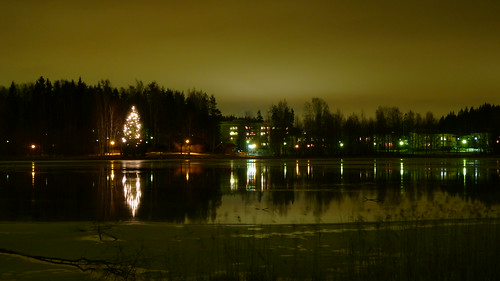What makes a photograph acceptable? There are all kinds of technical requirements - how black the blacks should be, can there be blown highlights, how the subject should be framed, is there motion or out-of-focus blur etc.
And then there are ways of naming some photos to be Art, and others not to be. I have never really understood what makes Art in the visual arts - in writing I do have some idea, but even that is elusive to put into words. Perhaps it is the same with photography - there are things difficult to define except by seeing from the inside, so to speak.
In any case, what I have learned from my personal, documentary, memento kind of photography is that some photos contain a bit more stuff than you seemingly put in, a kind of secret, mystery, even sprituality - which a lot said from a materialist like me.
But some photos are just the surface of the image, not much more. Here is (I think) one such photo, taken Saturday evening at a nearby lake. The colors are a bit strange thanks to difficulties with the white balance due to different kinds of light sources plus city lights reflected from clouds.
But even though this image is basically just eye candy, I like it. For me (because of the moment in time when I was taking it) it contains a meaning. For others, probably not.
Potash Hill Road
20 minutes ago




5 comments:
Meaning is always infused by the viewer. Some images lend themselves more to it, some less. We often hear that an image has "story", but that's not true. Single images can't tell stories, because a story has a timeline and a single image is a frozen point in time. Instead it is that some images have a certain quality that invites all kinds of viewers to invent all kinds of stories, and that's what makes them so successful.
And then there is your case. You suspect this is not such an image, and you are right, but for you the story is already written. You'd have a hard time to get it out of your head, to become an ideal, neutral viewer.
I guess this is one of the challenges in photography: to be able to anticipate the stories that an image will start in other people's heads.
Thanks for the reminder.
Thanks for pointing out this essential feature of photos, their potential to engage the story-telling part of the viewer's brain. I guess one way of getting distance to the photos you have taken would be forgetting about them for a while - weeks or months. But this is for me difficult, I have a need to work on the photos right after taking them.
So have I :)
I guess there is nothing wrong with the artist having an other relation to the image than the viewer. It's only something to keep in mind, because it explains a lot.
think there are any rules that make a photograph acceptable. the more one looks at photography, the more one realises that things like black point, tonal range etc are just craft.
To get at the "story" as Andreas puts it, photographs need to move beyond the mere pretty picture approach.
I've been really enjoying your photography, especially the movement shots. In fact many that you deem "unsuccessful" are very good indeed.
@doonster: Thank you for the encouragement.
Now that I have read some photography books and looked at some masterful examples by past and current practitioners, it feels that there are endless things to be discovered (if not learned) also on the craft side of photography.
Many of my photos have had less impact that I expected from the scene (some cases have been the opposite), and I haven't had a clue why it was so. Now some of these points have become apparent, one reason being the book "The Simple Secret to Better Painting" by Greg Albert, which is at the right level for me.
And it is perhaps also so that some of the instructions from the books and the web (and also the excellent photos posted on the sites in my blogroll) have caused a bit of insight to penetrate through my thick skull.
But it is a different thing to understand what the problem is than to be able to create better photos.
Post a Comment